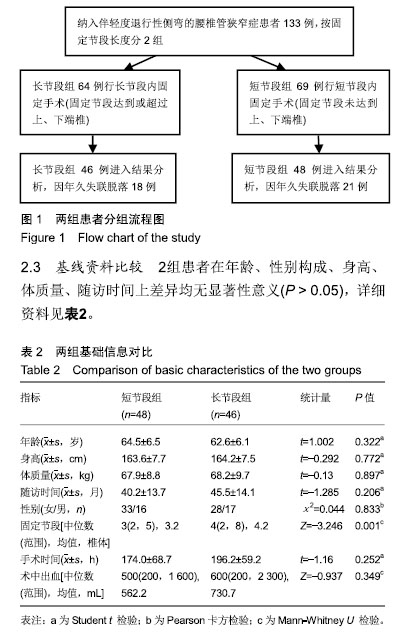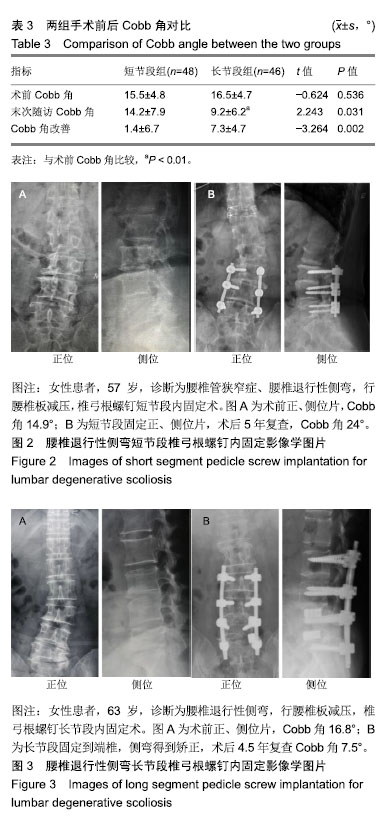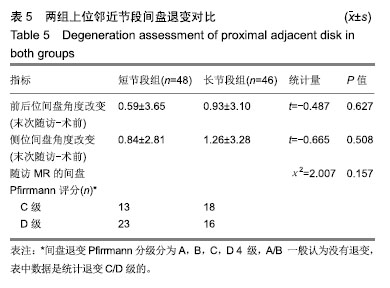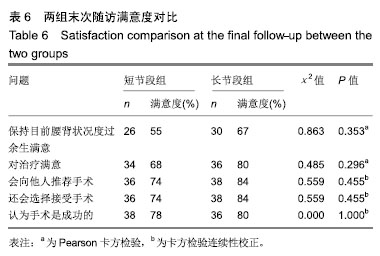Chinese Journal of Tissue Engineering Research ›› 2019, Vol. 23 ›› Issue (36): 5811-5817.doi: 10.3969/j.issn.2095-4344.1897
Previous Articles Next Articles
Comparison of limited fusion and full curve fusion for mild lumbar degenerative scoliosis with stenosis
He Da, Zhao Jingwei, Liu Bo, Tian Wei
- Department of Spine Surgery, Beijing Jishuitan Hospital, Beijing 100035, China
-
Online:2019-12-28Published:2019-12-28 -
Contact:Tian Wei, MD, Chief physician, Department of Spine Surgery, Beijing Jishuitan Hospital, Beijing 100035, China -
About author:He Da, MD, Associate chief physician, Department of Spine Surgery, Beijing Jishuitan Hospital, Beijing 100035, China -
Supported by:the National Key Clinical Speciality Construction Project (to Beijing Jishuitan Hospital)| the Beijing Hospital Administration’s “Mission” Talent Plan, No. SML20150401 (to TW)
CLC Number:
Cite this article
He Da, Zhao Jingwei, Liu Bo, Tian Wei. Comparison of limited fusion and full curve fusion for mild lumbar degenerative scoliosis with stenosis[J]. Chinese Journal of Tissue Engineering Research, 2019, 23(36): 5811-5817.
share this article

2.5 功能评分比较 无论短节段或是长节段固定,患者的术后ODI、Roland Morris指数、目测类比评分、日本骨科学会评分均较术前显著改善(P均≤ 0.005),说明无论何种行何种术式,术后患者的生活质量均有明显提高,见表4。 在目测类比评分、ODI、日本骨科学会评分、Roland Morris指数等评分方面,无论术前、术后还是改善率,2组之间差异均无显著性意义(P > 0.05);但从均值上看,长节段组各评分改善程度高于短节段组,见表4。 另外就ODI和日本骨科学会评分问卷中的各个问题进行逐项分析,发现与短节段组相比,长节段组术后在“行走功能”方面有一定改善(P < 0.05),见表4。"
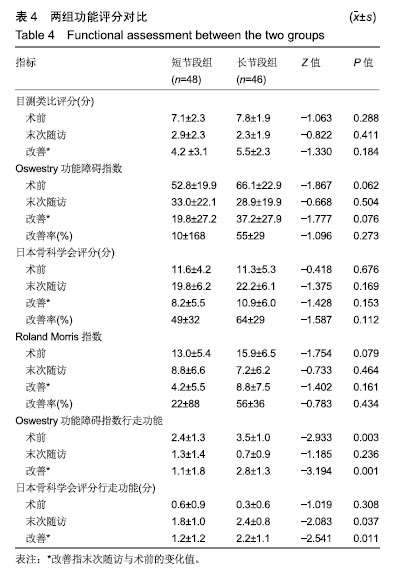
| [1]Ploumis A, Transfledt EE, Denis F. Degenerative lumbar scoliosis associated with spinal stenosis. Spine J. 2007;7:428-436.[2]Transfeldt EE, Topp R, Mehbod AA, et al. Surgical outcomes of decompression, decompression with limited fusion, and decompression with full curve fusion for degenerative scoliosis with radiculopathy. Spine. 2010;35:1872-1875.[3]袁宁,田伟,刘波,等.成人脊柱侧凸的手术治疗策略[J]. 骨科临床与研究杂志,2017,2(3):159-164.[4]Simmons ED. Surgical treatment of patients with lumbar spinal stenosis with associated scoliosis. Clin Orthop Relat Res. 2001; (384):45-53.[5]Simmons EDJ, Simmons EH. Spinal stenosis with scoliosis. Spine (Phila Pa 1976). 1992;17:S117-120.[6]Gupta MC. Degenerative scoliosis. Options for surgical management. Orthop Clin North Am. 2003;34:2692-79.[7]Silva FE, Lenke LG. Adult degenerative scoliosis: evaluation and management. Neurosurg Focus. 2010;28:E1.[8]Aebi M. The adult scoliosis. Eur Spine J. 2005;14:925-948.[9]Liu Z, Zhao QH, Wu XZ, et al. Short fusion and long fusion for degenerative lumbar scoliosis with lumbar stenosis. Zhonghua Yi Xue Za Zhi. 2012;92:1751-1755.[10]Liu W, Chen XS, Jia LS, et al. The clinical features and surgical treatment of degenerative lumbar scoliosis: a review of 112 patients. Orthop Surg. 2009;1:176-183.[11]Cho KJ, Suk SI, Park SR, et al. Short fusion versus long fusion for degenerative lumbar scoliosis. Eur Spine J. 2008;17:650-656. [12]Kotwal S, Pumberger M, Hughes A, et al. Degenerative scoliosis: a review. HSS J. 2011;7:257-264.[13]Bae HW, Rajaee SS, Kanim LE. Nationwide trends in the surgical management of lumbar spinal stenosis. Spine(Phila Pa 1976). 2013; 38:916-926.[14]Hioki A, Miyamoto K, Kodama H, et al. Two-level posterior lumbar interbody fusion for degenerative disc disease: improved clinical outcome with restoration of lumbar lordosis. Spine J. 2005;5:600-607.[15]Bridwell KH. Selection of instrumentation and fusion levels for scoliosis: where to start and where to stop. Invited submission from the joint section meeting on disorders of the spine and peripheral nerves, March 2004. J Neurosurg Spine. 2004;1:1-8.[16]Birknes JK, White AP, Albert TJ, et al. Adult degenerative scoliosis: a review. Neurosurgery. 2008;63:94-103.[17]Ploumis A, Liu H, Mehbod AA, et al. A correlation of radiographic and functional measurements in adult degenerative scoliosis . Spine (Phila Pa 1976). 2009;34:1581-1584.[18]Glassman SD, Berven S, Bridwell K, et al. Correlation of radiographic parameters and clinical symptoms in adult scoliosis . Spine (Phila Pa 1976). 2005;30:682-688.[19]Glassman SD, Bridwell K, Dimar JR, et al. The impact of positive sagittal balance in adult spinal deformity . Spine (Phila Pa 1976). 2005; 30:2024-2029.[20]Schwab F, Dubey A, Gamez L, et al. Adult scoliosis: prevalence, SF-36, and nutritional parameters in an elderly volunteer population . Spine (Phila Pa 1976). 2005;30:1082-1085.[21]Daubs MD, Lenke LG, Bridwell KH, et al. Does correction of preoperative coronal imbalance make a difference in outcomes of adult patients with deformity? Spine (Phila Pa 1976). 2013;38:476-483.[22]Zurbriggen C, Markwalder TM, Wyss S. Long-term results in patients treated with posterior instrumentation and fusion for degenerative scoliosis of the lumbar spine. ActaNeurochir (Wien). 1999;141:21-26.[23]Weidenbaum M. Considerations for focused surgical intervention in the presence of adult spinal deformity . Spine (Phila Pa 1976). 2006;31: S139-143.[24]Schwab FJ, Smith VA, Biserni M, et al. Adult scoliosis: a quantitative radiographic and clinical analysis. Spine (Phila Pa 1976). 2002;27: 387-392.[25]Li F, Chen Q, Chen W, et al. Posterior-only approach with selective segmental TLIF for degenerative lumbar scoliosis. J Spinal Disord Tech. 2011;24:308-312.[26]Kumar MN, Baklanov A, Chopin D. Correlation between sagittal plane changes and adjacent segment degeneration following lumbar spine fusion. Eur Spine J. 2001;10:314-319.[27]Hai Y, Meng X. Selective Posterior Decompression and short segmental fusion of degenerative lumbar scoliosis. Spine J. 2010;10: S62-63.[28]Ledonio CGT, Polly Jr. DW, Crawford III CH, et al. Adult Degenerative Scoliosis Surgical Outcomes: A Systematic Review and Meta-analysis. Spine Deform. 2013;1:248-258.[29]Tsai TH, Huang TY, Lieu AS, et al. Functional outcome analysis: instrumented posterior lumbar interbody fusion for degenerative lumbar scoliosis. Acta Neurochir (Wien). 2011;153:547-555.[30]Li F, Chen Q, Chen W, et al. Posterolateral lumbar fusion versus transforaminal lumbar interbody fusion for the treatment of degenerative lumbar scoliosis. J Clin Neurosci. 2013;20:1241-1245.[31]Cho KJ, Suk SI, Park SR, et al. Selection of proximal fusion level for adult degenerative lumbar scoliosis . Eur Spine J. 2013;22:394-401.[32]Shufflebarger H, Suk SI, Mardjetko S. Debate: determining the upper instrumented vertebra in the management of adult degenerative scoliosis: stopping at T10 versus L1. Spine. 2006;31:S185-194.[33]O'Shaughnessy BA, Bridwell KH, Lenke LG, et al. Does a long-fusion "T3-sacrum" portend a worse outcome than a short-fusion "T10-sacrum" in primary surgery for adult scoliosis? Spine. 2012;37: 884-890. |
| [1] | Li Dadi, Zhu Liang, Zheng Li, Zhao Fengchao. Correlation of total knee arthroplasty efficacy with satisfaction and personality characteristics [J]. Chinese Journal of Tissue Engineering Research, 2021, 25(9): 1346-1350. |
| [2] | Zhang Chong, Liu Zhiang, Yao Shuaihui, Gao Junsheng, Jiang Yan, Zhang Lu. Safety and effectiveness of topical application of tranexamic acid to reduce drainage of elderly femoral neck fractures after total hip arthroplasty [J]. Chinese Journal of Tissue Engineering Research, 2021, 25(9): 1381-1386. |
| [3] | Yao Rubin, Wang Shiyong, Yang Kaishun. Minimally invasive transforaminal lumbar interbody fusion for treatment of single-segment lumbar spinal stenosis improves lumbar-pelvic balance [J]. Chinese Journal of Tissue Engineering Research, 2021, 25(9): 1387-1392. |
| [4] | Lü Zhen, Bai Jinzhu. A prospective study on the application of staged lumbar motion chain rehabilitation based on McKenzie’s technique after lumbar percutaneous transforaminal endoscopic discectomy [J]. Chinese Journal of Tissue Engineering Research, 2021, 25(9): 1398-1403. |
| [5] | Wang Mengting, Gu Yanping, Ren Wenbo, Qin Qian, Bai Bingyi, Liao Yuanpeng. Research hotspots of blood flow restriction training for dyskinesia based on visualization analysis [J]. Chinese Journal of Tissue Engineering Research, 2021, 25(8): 1264-1269. |
| [6] | Gao Yan, Zhao Licong, Zhao Hongzeng, Zhu Yuanyuan, Li Jie, Sang Deen. Alteration of low frequency fluctuation amplitude at brain-resting state in patients with chronic discogenic low back pain [J]. Chinese Journal of Tissue Engineering Research, 2021, 25(8): 1160-1165. |
| [7] | Zeng Zhen, Hu Jingwei, Li Xuan, Tang Linmei, Huang Zhiqiang, Li Mingxing. Quantitative analysis of renal blood flow perfusion using contrast-enhanced ultrasound in rats with hemorrhagic shock during resuscitation [J]. Chinese Journal of Tissue Engineering Research, 2021, 25(8): 1201-1206. |
| [8] | Kong Desheng, He Jingjing, Feng Baofeng, Guo Ruiyun, Asiamah Ernest Amponsah, Lü Fei, Zhang Shuhan, Zhang Xiaolin, Ma Jun, Cui Huixian. Efficacy of mesenchymal stem cells in the spinal cord injury of large animal models: a meta-analysis [J]. Chinese Journal of Tissue Engineering Research, 2021, 25(7): 1142-1148. |
| [9] | Jing Huimin, Yu Wenjuan, Wang Sijia, Chen Cong, Li Yifan, Wang Yonglan, Li Xin, Zhang Juan, Liang Meng. Resting-state functional magnetic resonance imaging evaluation of the brain’s default mode network in patients with sleep bruxism [J]. Chinese Journal of Tissue Engineering Research, 2021, 25(5): 685-689. |
| [10] | Luo Xuanxiang, Jing Li, Pan Bin, Feng Hu. Effect of mecobalamine combined with mouse nerve growth factor on nerve function recovery after cervical spondylotic myelopathy surgery [J]. Chinese Journal of Tissue Engineering Research, 2021, 25(5): 719-722. |
| [11] | Hong Xuezhi, Liu Lei, Yao Yunqian, Jiang Yuxin, Xu Jia, Mo Hanyou. Meta-analysis of complications and functional recovery of the hip after total hip arthroplasty in patients with systemic lupus erythematosus [J]. Chinese Journal of Tissue Engineering Research, 2021, 25(27): 4415-4420. |
| [12] | Yue Heng, Zhen Ping, Liang Xiaodi. Low-intensity focused ultrasound and low-intensity pulsed ultrasound for mild traumatic knee osteoarthritis: differences in pain and function [J]. Chinese Journal of Tissue Engineering Research, 2021, 25(26): 4101-4105. |
| [13] | Wang Xuan, Zhou Chao, Zhang Yingzi. Research, application and development of human amniotic epithelial cells in the field of obstetrics and gynecology [J]. Chinese Journal of Tissue Engineering Research, 2021, 25(25): 4070-4075. |
| [14] | Tian Yang, Tang Chao, Liao Yehui, Tang Qiang, Ma Fei, Zhong Dejun. Consistency and repeatability of CT and MRI in measurement of spinal canal area in patients with lumbar spinal stenosis [J]. Chinese Journal of Tissue Engineering Research, 2021, 25(24): 3882-3887. |
| [15] | Wang Yihan, Li Yang, Zhang Ling, Zhang Rui, Xu Ruida, Han Xiaofeng, Cheng Guangqi, Wang Weil. Application of three-dimensional visualization technology for digital orthopedics in the reduction and fixation of intertrochanteric fracture [J]. Chinese Journal of Tissue Engineering Research, 2021, 25(24): 3816-3820. |
| Viewed | ||||||
|
Full text |
|
|||||
|
Abstract |
|
|||||

